All-on-4® Dental Implants: What You Need to Know
Anna Roth

Dr. Guzin
Medical Reviewer
Are you tired of living with missing teeth or ill-fitting dentures?
Do you dream of a permanent solution that can restore your smile and improve your quality of life?
All-on-4® dental implants is a perfect solution for you- a revolutionary tooth replacement option that provides a full arch of fixed, natural-looking teeth with just four implants.
What Are All-on-4 Dental Implants?
All-on-4® is a treatment concept developed by implant manufacturer Nobel Biocare. It involves placing four specially designed dental implants in strategic positions in the jaw to support a full fixed bridge of replacement teeth. The key is the two rear implants, which are longer and angled to maximize contact with available bone.
This innovative approach allows even patients who have experienced bone loss to enjoy the benefits of implant-supported teeth, often without the need for bone grafting. The result is a stable, comfortable, and natural-looking smile that looks, feels and functions like healthy natural teeth.
Some key facts about All-on-4® dental implants:
- Uses just 4 implants per arch (upper or lower jaw)
- Can replace an entire arch of missing teeth
- Provides a fixed full-arch prosthesis
- Often eliminates the need for bone grafting
All-on-4® allows you to get a brand new fixed set of teeth, with a simpler and quicker process compared to getting individual implants for each missing tooth.

All-on-4 Dental Implant Before and After
Benefits of All-on-4® Dental Implants
All-on-4® dental implants offer numerous advantages over other tooth replacement options. Here are some of the top benefits:
- Natural Look and Feel: All-on-4® restorations are custom-made to match your natural teeth in shape, size, and color. Most people won’t be able to tell them apart from real teeth. You’ll be able to smile, speak and eat with total confidence.
- Restores Full Bite Function: With All-on-4®, you’ll regain 100% of your natural biting and chewing capacity. You can eat all your favorite foods again, from steak to apples, without any discomfort or restrictions. This also makes it easier to maintain a balanced diet, which is important for overall health.
- Prevents Bone Loss: Dental implants are the only tooth replacement that stops bone loss. Just like natural tooth roots, implants stimulate the jawbone when you chew. This keeps the bone strong and healthy. Without this stimulation, the bone starts to deteriorate, leading to a sunken, aged facial appearance and health issues.
- Rapid Recovery: With All-on-4®, you can get a brand new smile in just one day. The procedure itself takes about 2-3 hours per arch under local anesthesia or IV sedation. You’ll leave with a temporary set of fixed teeth. You’ll get your permanent zirconia bridge after 3-6 months of healing. Most patients return to work and normal activities within a few days.
- Easy Care and Maintenance: Taking care of All-on-4® is easy – just brush and floss like natural teeth. Unlike dentures, you never have to take them out. Regular checkups with your dentist will help ensure your new smile lasts a lifetime.
- Boosts Self-Esteem: Replacing your missing teeth with fixed implants that look and feel like yours can work wonders for your self-confidence. You’ll no longer feel the need to hide your smile or avoid social situations. You can express yourself fully and enjoy better emotional well-being.
Drawbacks of All-on-4®
As with any dental treatment, All-on-4® does have some potential drawbacks to be aware of:
- Higher Cost: All-on-4® is more expensive than traditional dentures or bridges. The average cost ranges from $20,000 to $30,000 per arch. However, a few options are often available to make the treatment more affordable. And we can help you get all on 4 in $8500 per arch with the same materials and 5 year guarantee.
- Surgery Required: Placing dental implants does require oral surgery. You’ll undergo a multi-step procedure that involves cutting into the gums, drilling into the jawbone and attaching the implants.
- Lengthy Process: While you can get a temporary set of teeth on the same day as implant surgery, the entire All-on-4® process takes several months from start to finish. It takes time for the implants to fuse with the bone (osseointegration) before the permanent teeth can be placed.
- Requires Healthy Gums and Adequate Bone: You must have healthy gums and enough bone in the jaw to support the implants. If you have active gum disease, it will need to be treated first. While All-on-4® can often work even with some bone loss, severe bone loss may require additional grafting.
- Not Suitable for Everyone: All-on-4® may not be recommended if you have certain health conditions that impair healing, such as uncontrolled diabetes or a weakened immune system. A history of smoking or radiation to the head/neck area may also make you ineligible.
Cost of All on 4 Dental Implants
The cost of All-on-4 dental implants varies depending on several factors:
- Geographic location
- Dentist’s expertise
- Materials used
- Additional procedures required (e.g., extractions or bone grafting)
On average, patients pay between $20,000 and $30,000 per arch in the United States.
Wait! there is a way to save up to 75% with HebeDoc approved dentists in Mexico. The same $33,469 all-on-4, Nobel Biocare arch installed in the US may be had for $8,500 – $12,000 with one of our HebeDoc approved dentists in Mexico. That’s right. It’s the same high-quality dental prosthetic, installed by a dental specialist.
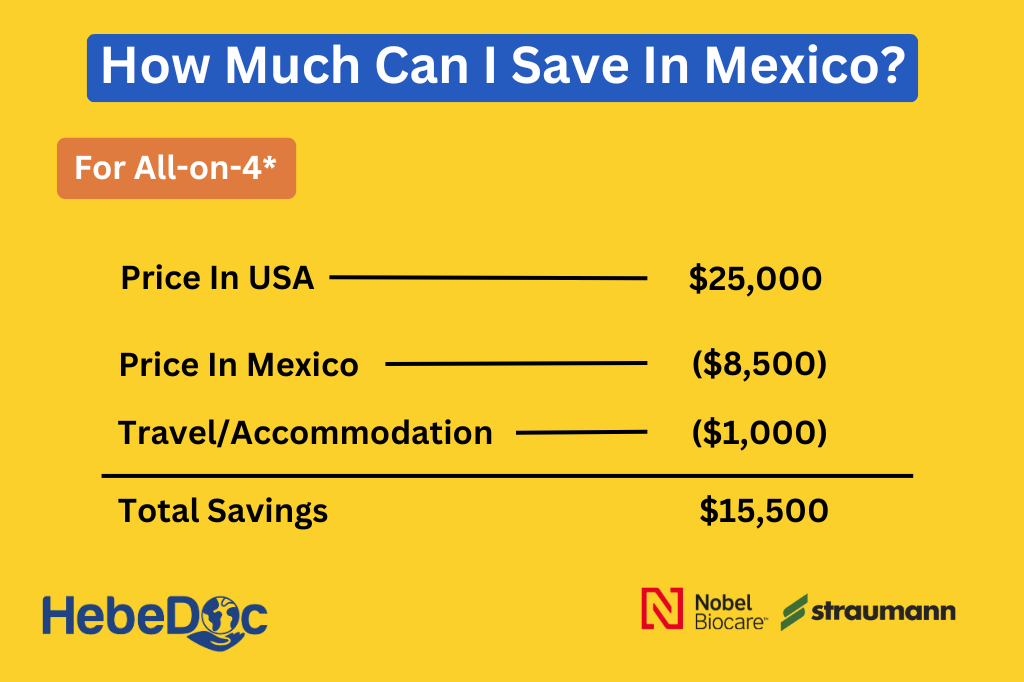
All-on-4® vs Other Tooth Replacement Options
When it comes to replacing missing teeth, you have several options to choose from. Let’s see how All-on-4® compares to the alternatives:
All-on-4® Dental Implant Procedure
If you’re considering All-on-4®, it’s important to understand what’s involved in the treatment process. Here’s a step-by-step guide to what you can expect:
Consultation and Treatment Planning
Your All-on-4 journey begins with a consultation with a dental implant specialist. They will:
- Review your medical and dental history
- Examine your mouth, teeth and gums
- Take x-rays and 3D scans to evaluate your jawbone density
- Discuss your needs, preferences and smile goals
- Taking impressions and photos of your teeth and gums
- Designing your temporary and permanent replacement teeth
Implant Placement Surgery
On the day of surgery, you’ll first be given anesthesia so you don’t feel any pain.
Once you’re numb or asleep, the oral surgeon will:
- Make small incisions in the gums to expose the bone
- Place the 4 implants (2 anterior, 2 posterior angled) at the correct depth and angle
- Attach abutments (support posts) to the implants
- Place a temporary acrylic bridge on the abutments and adjust the fit
The surgery itself usually takes about 2-3 hours per arch. You’ll be able to go home shortly afterward, once the anesthesia wears off. Be sure to have someone with you as you won’t be able to drive yourself.
Recovery and Healing
It’s normal to experience some pain, swelling and bruising after implant surgery. This can be managed with:
- Prescribed pain medication and antibiotics
- Gentle salt water rinses
- Soft, cool foods like smoothies and soups
- Avoiding smoking and alcohol
- Getting plenty of rest
Any discomfort should improve significantly after the first 2-3 days and subside completely within a week. You’ll have a follow-up visit to check your healing progress and adjust the temporary teeth if needed.
Over the next 3-6 months, the implants will fuse with the surrounding jawbone in a process called osseointegration. This creates a strong, stable foundation for your permanent teeth. You’ll continue wearing the temporary bridge during this healing period.
Permanent Teeth Placement
Once your implants have fully integrated, you’re ready for your permanent All-on-4® prosthesis. This is typically a fixed bridge made of all-ceramic zirconia, known for its strength, durability and natural appearance.
At this appointment, your surgeon will:
- Remove the temporary bridge and abutments
- Place the final abutments onto the implants
- Check the fit, bite and aesthetics of the permanent bridge
- Make any necessary adjustments
- Secure the permanent All-on-4® bridge onto the abutments
You’ll be given care instructions for your new teeth, including recommendations for daily hygiene, eating habits and regular checkups. Expect a few follow-up visits to monitor your implants and make sure you’re adapting well to the permanent bridge.
What to Expect After All-on-4® Implant Surgery
The first few days after All-on-4® implant placement are the most crucial for recovery. Here’s a timeline of what you can expect and how to care for yourself each step of the way:
Day of Surgery
- Bleeding: Some oozing and bloody saliva is normal for the first 24-48 hours. Gently bite on gauze packs to help stop bleeding. Change them every 30-60 minutes until blood flow subsides.
- Swelling: Your face, cheeks, and under-eye area may be swollen and bruised. This usually peaks on day 3 and subsides within a week. Minimize swelling by applying an ice pack for 15 minutes on, 15 minutes off.
- Pain: Take your prescribed pain medication as directed before the anesthesia wears off. Stay ahead of discomfort by taking meds on schedule. Avoid aspirin as it can increase bleeding.
- Temporary teeth: Your dentist placed an acrylic bridge on the implants. Be gentle with these temporary teeth, avoiding hard, crunchy, or sticky foods. Don’t brush them vigorously.
- Activity: Rest with your head elevated above your heart to reduce swelling and bleeding. Avoid strenuous activity, bending over, or blowing your nose. No smoking or using straws as this can dislodge blood clots.
Day 2-6
- Oral hygiene: Don’t brush or floss around the implant sites for the first few days to avoid disturbing them. Gently rinse with warm salt water or prescribed antimicrobial rinse 3-4 times daily to keep the area clean.
- Eating: Stick to a soft food diet like smoothies, soups, mashed potatoes, yogurt, and scrambled eggs. Avoid foods that are hot, spicy, crunchy, or require chewing. Drink plenty of water but don’t use straws.
- Follow-up: You’ll have a postoperative visit to check healing and remove any stitches as needed. Your dentist may take impressions for your final bridge at this time. Follow all care instructions closely.
Week 2 and Beyond
- Pain and swelling should be dramatically improved and your implants will start feeling more natural. You can generally resume normal, non-strenuous activities.
- Slowly reintroduce more solid foods and chew on both sides of your mouth evenly. Still avoid extremely hard, crunchy, or sticky foods that could damage the implants or temporary bridge.
- Brush your temporary teeth gently with a soft-bristle toothbrush. Continue warm salt water rinses 3-4 times a day, especially after meals. Don’t use an electric toothbrush around the surgical sites yet.
- You’ll have periodic checkups to monitor your implants’ integration and design your permanent All-on-4® prosthesis. Report any persistent pain, swelling, or mobility of the implants to your surgeon.
Remember, everyone heals differently. Some people may experience little pain and eat normally within a few days while others take a few weeks to feel back to 100%. Listen to your body, take it easy, and contact your dentist with any concerns. With proper care, you’ll be enjoying your new smile in no time!
Diet After All-on-4® Dental Implants
One of the most common questions people have about All-on-4® is what they can eat after surgery. The good news is that once your permanent teeth are placed, you can enjoy all your favorite foods again! However, you’ll need to follow a modified diet in the meantime to protect your implants and aid healing. Here’s a stage-by-stage guide:
Day of Surgery
Stick to clear liquids and very soft foods that require no chewing, such as:
- Water
- Broth or clear soups
- Jell-O
- Smoothies (no seeds or chunks)
- Pudding
- Popsicles (no nuts or fruit pieces)
Avoid anything hot, spicy, crunchy, or chewy that could irritate the surgical sites. No straws or smoking as this can dislodge blood clots.
First Week Post-Op
Focus on soft, nutrient-dense foods high in protein, vitamins, and minerals to promote healing. Good options include:
- Smoothies with protein powder
- Pureed soups
- Scrambled eggs or egg salad
- Greek yogurt, cottage cheese
- Mashed potatoes or sweet potatoes
- Soft-cooked vegetables like squash
- Flaky fish
- Oatmeal, cream of wheat
- Tofu, hummus, refried beans
- Soft bread, pasta, rice
Avoid chewing directly on the implant sites. Cut food into small pieces and chew slowly using your back teeth. Drink plenty of water but don’t use straws.
Week 2-3
As you heal, you can start incorporating more solid foods while still avoiding anything too hard, crunchy, or chewy. Aim for soft-textured proteins and produce like:
- Ground meats, meatloaf, meatballs
- Baked or mashed fish
- Steamed, soft-cooked veggies
- Soft fruits like bananas, melons, berries
- Pancakes, waffles, French toast
- Macaroni and cheese, ravioli, gnocchi
- Soft sandwiches without crusty bread
Listen to your body and don’t eat anything that causes pain. Cut food into bite-size pieces and chew evenly on both sides of your mouth.
Permanent Teeth Placement
After your implants fuse with the bone (3-6 months), your permanent fixed bridge will be attached. With this final All-on-4® prosthesis, you can eat whatever you want – though it’s still smart to exercise some caution at first.
Longevity of All-on-4 Dental Implants
With a lifespan averaging 20 years, all-on-4 implants offer a long-lasting solution. Factors influencing the longevity include the materials used for the prosthetic teeth, oral hygiene, and preventive measures against chips or cracks. Regular dental care and professional cleanings are crucial to maintaining the implants’ durability.
Conclusion:
If you’re struggling with missing teeth or uncomfortable dentures, All-on-4® may be the solution you’ve been seeking. It has helped thousands of people reclaim their smiles, confidence, and quality of life. While no dental procedure is right for everyone, All-on-4®’s advantages make it a top choice for many.
All-on-4® is a innovative solution for missing or failing teeth that uses just 4 implants to support a full fixed bridge.
While the cost of All-on-4® is higher than other options, its durability and profound benefits make it an excellent investment for the right candidates. With proper care and maintenance, All-on-4® implants can last 20+ years.
A healthy, beautiful smile is priceless – and with All-on-4®, it’s possible in just one day. Don’t let missing teeth hold you back any longer. Take the first step towards a new smile and lease on life by exploring the life-changing potential of All-on-4® dental implants.

Dr. Guzin
Ankara Turkey
Dr. Guzin Kırsaçlıoğlu graduated from Ankara Dental School in 1982 and opened her own practice. Dr.Kirsaçlioglu completed her Master’s in Cosmetic Dentistry at New York University in 2011 as well as annual continuing education courses on dental implants in France, Germany, Spain, and Israel. Today, Dr. Kirsaçlioglu is an internationally recognized, multidisciplinary dental professional running a dental practice with a staff of 18.
She is a member of the American Dental Association (ADA), the Turkish Dental Association (TDB), European Academy of Esthetic Dentistry (EAED), American Academy of Cosmetic Dentistry (AAD) and the European Association for Osseointegration (EAO).
She has authored numerous dental related articles covering the topics of both dental implants and dental aesthetics. When not treating patients, Dr Kirsaçlioglu volunteers in rural villages, teaching children about good oral health and preventative dental care.
The Right Dental Specialist at a Fraction of the Cost. HebeDoc works with only the top 5% of dentists, thoroughly vetted with quality and affordability in mind.
100% free, non-binding assessment.
Get Quote
The Dental Professionals
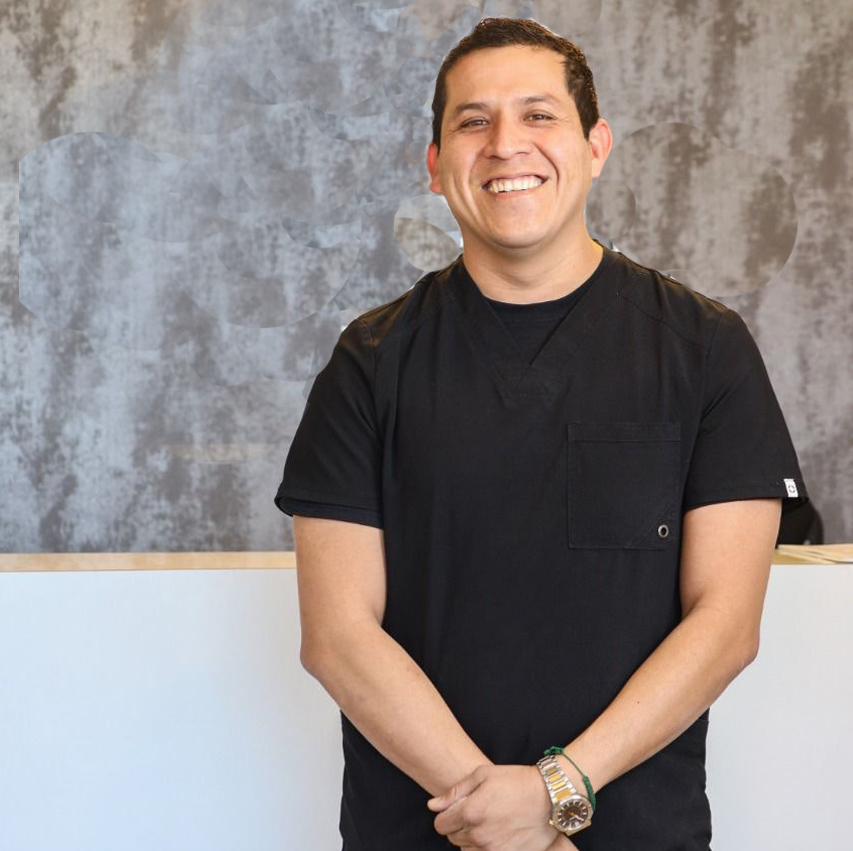
Dr. Corrales
-
Los Algodones, Mexico
(Yuma Arizona Border)
-
Tijuana, Mexico
(San Diego Border)
- Experience: 13+ years
- Language: English, Spanish

- Ankara, Turkey
- Experience: 31+ years
- Language: English,Turkish
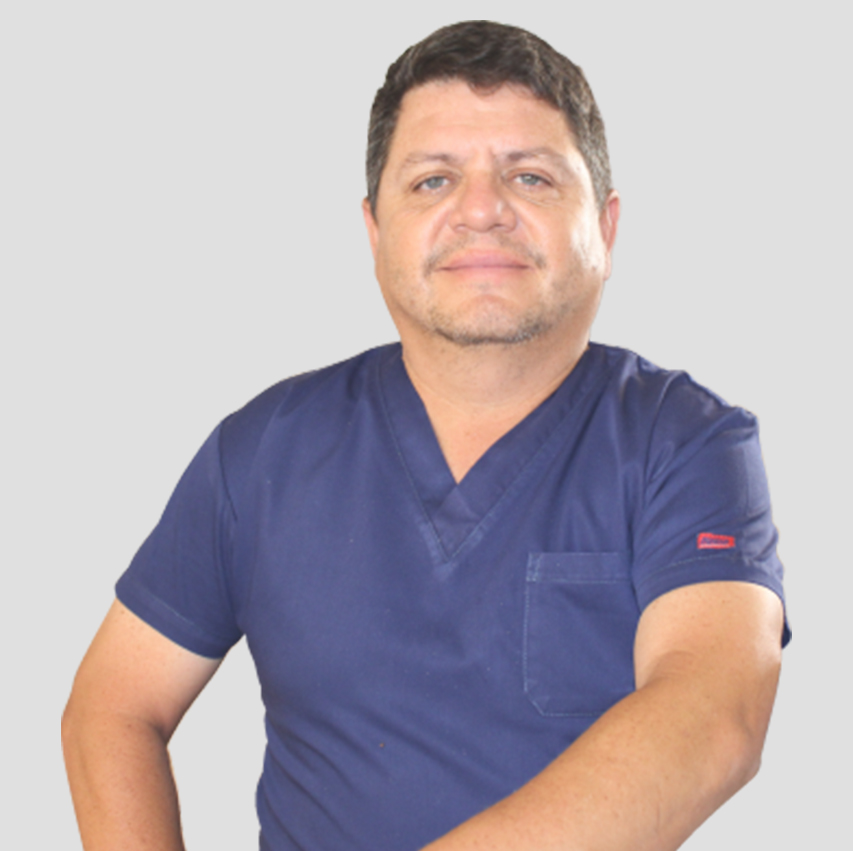
- Los Algodones, México (Yuma Arizona)
- Experience: 20+ years
- Language: English, Spanish
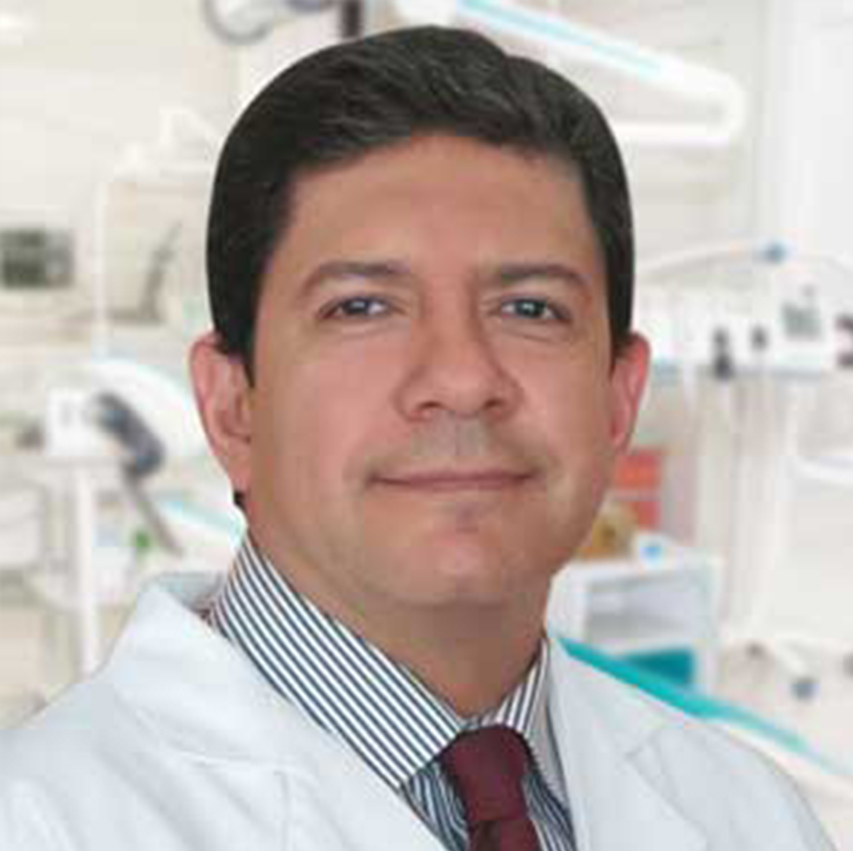
- Cancun, Mexico
- Experience: 36+ years
- Language: English, Spanish

- Ankara, Turkey
- Experience: 6+ years
- Language: English,Turkish
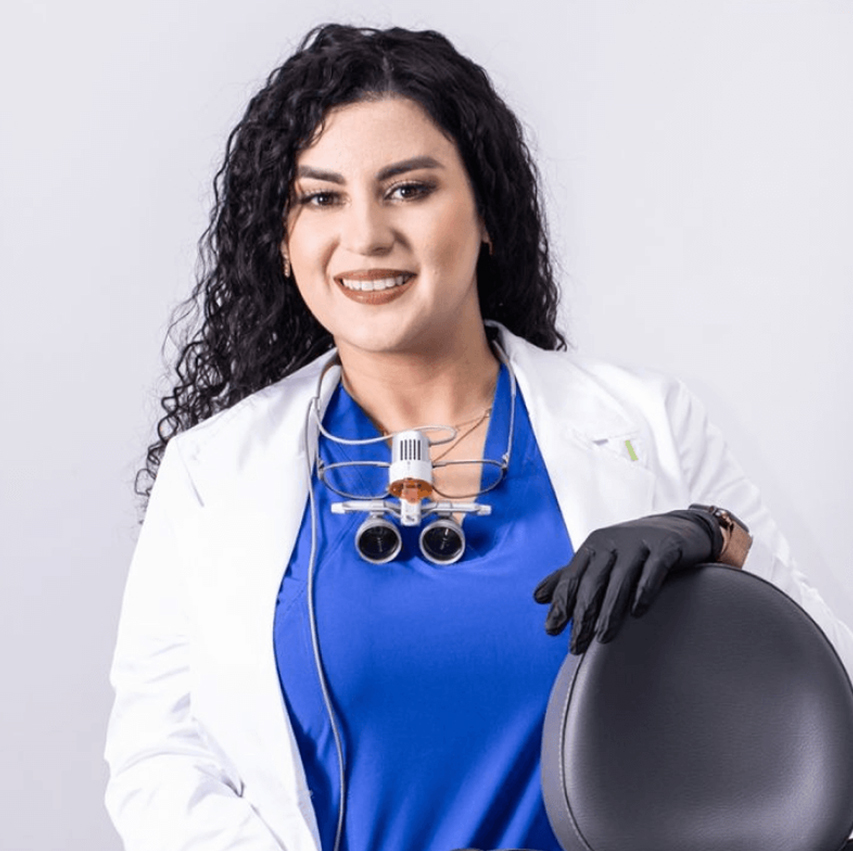
- Los Algodones, Mexico (Yuma Arizona Border)
- Experience: 11+ years
- Language: English, Spanish

- Ankara, Turkey
- Experience: 7+ years
- Language: English,Turkish
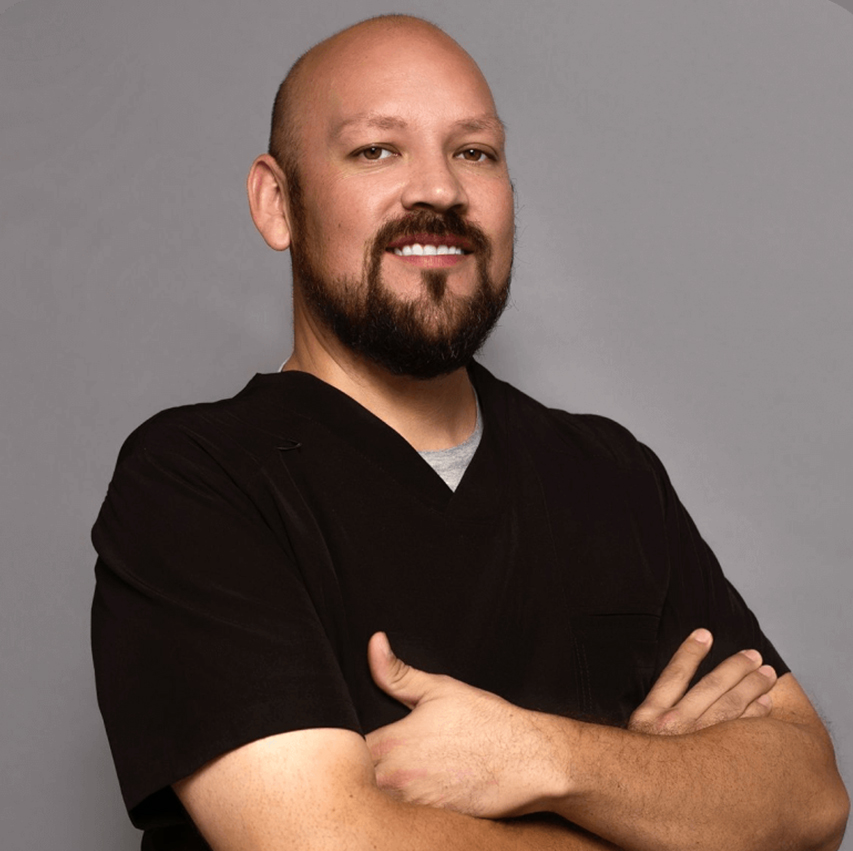
- Los Algodones, Mexico (Yuma Arizona Border)
- 4.9 (15 reviews)
- Experience: 15+ years
- Language: English, Spanish

- Ankara, Turkey
- Experience: 10+ years
- Language: English,Turkish
